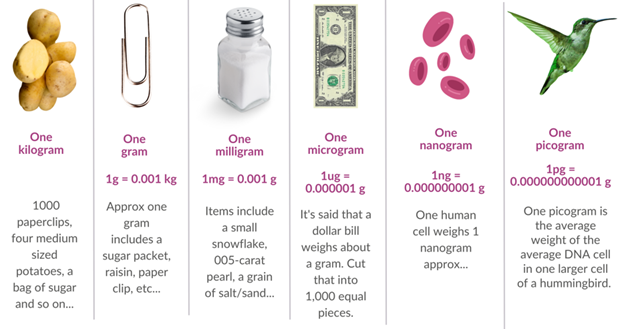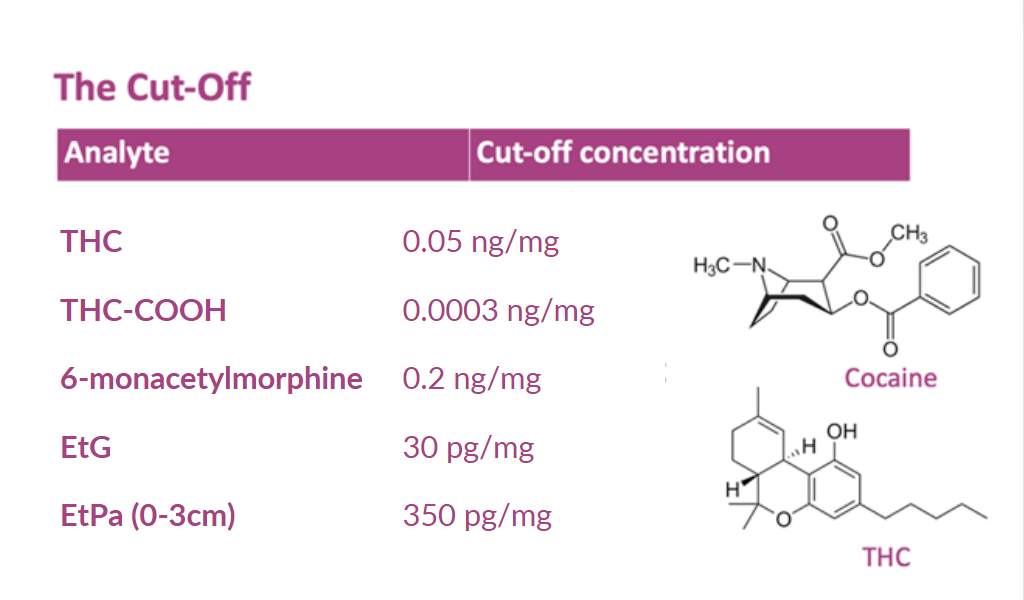CANSFORD LABS
Debunking the myth about sensitivity regarding UK drug and alcohol testing
on Apr 15, 2024
 In this new blog, Cansford's Reporting Scientist Jayne Hazon examines the myths regarding sensitivity and the things you need to know about the science behind the marketing.
In this new blog, Cansford's Reporting Scientist Jayne Hazon examines the myths regarding sensitivity and the things you need to know about the science behind the marketing.
At a recent family law conference here in the UK, a member of our team picked up a leaflet from another laboratory. It claimed to be '10 times more sensitive than other providers’.
This got us thinking.
Sensitivity is undoubtedly important, but the use of sensitivity to report low concentrations – as perhaps is inferred in the leaflet quoted - is not always appropriate. To understand more, and for some real-life scenarios that demonstrate this, read on....
To begin with, let’s explain some of the basic terms and concepts that we use to provide an understanding of how small the concentrations of drugs and drug metabolites are that we are testing for.
Units of Measurement

- Milligram is one thousandth of a gram
- Microgram is one millionth of a gram
- Nanogram is one thousand-millionth of a gram
- Picogram is one trillionth of a gram
Reporting cut-offs
As a starting point we need to be able to detect drugs and drug metabolites at a cut off which is appropriate for the demographic of people we are testing. At Cansford, we use the Society of Hair Testing cut-offs which are recognised throughout the industry.
The reporting cut-offs are used to determine if an analyte is detected or not detected.
A concentration of drug or drug metabolite that is above the reporting cut off is detected, and a concentration that is present below the reporting cut off is not detected.

So, as you can see, we need sensitive methods to detect really small amounts of drugs and drug metabolites.
Below the reporting cut off is the limit of detection.
The limit of detection (LOD) in drug and alcohol testing is the lowest concentration of a drug or drug metabolite that can be reliably detected and distinguished from other compounds.
The more sensitive an instrument or the overall analytical technique the lower the limit of detection can be set.
This limit is a validated limit, which we have demonstrated to UKAS that we can reliably detect. It is possible that we will detect drugs and drug metabolites below this level.
So, what is sensitivity?
In scientific terms it is the ‘response per unit concentration’. The response is the amount of electrical signal which is detected on the instrument per nanogram or picogram of drug or drug metabolite that enters the instrument.
The greater the response per unit of drug, the bigger the signal, this means it’s easier to distinguish smaller concentrations of drugs and drug metabolites from other substances or compounds.
Why do we need sensitivity in hair drug and alcohol testing?
Some drugs and drug metabolites require highly sensitive methods either because the metabolite exists in small amounts or because the drug or drug metabolite is poorly incorporated into the hair.
In some circumstances it is relevant to be able to report drugs and drug metabolites below the cut-off. For example, in child cases, spiking incidents, or when it is a metabolite has several parent drugs in common. More sensitivity can help to make the instruments more robust and more reliable, meaning that performance of the instrument or method can vary without having an impact on the results.
How sensitivity is achieved
Some laboratories will take a lot of hair at the sample collection, this can leave a donor distressed and reluctant to have hair samples taken in the future. For this reason, we aim to take the minimum amount of hair possible.
Sometimes it is not possible to collect a lot of hair from donors, either because they are reluctant or unwilling for the collector to take more hair or because their hair is sparse. Therefore, because we have used other methods to optimise our sensitivity Cansford isn’t reliant on receiving a large sample volume of hair at the laboratory.
Investment and R&D
We continue to invest in some of the best instruments in the industry, technology has advanced a lot in recent years and the instruments used at Cansford are at the forefront of this technology. Our instruments are maintained to a high standard, the instruments undergo daily checks and regular maintenance to ensure that they are performing at their best.
We have carefully optimised the techniques used when preparing the hair for analysis, meaning that we have maximised the amount of drugs and drug metabolites that are extracted from the hair sample.
Some companies may use a longer run time to separate out the drugs and drug metabolites on the instrument. This can improve the response to the drug / drug metabolite on the instrument because the instrument is only looking for one drug or drug metabolite at any one time.
At Cansford Laboratories we don’t have to do this, the instruments we use are capable of handling multiple drugs and drug metabolites within a very short window of time, making our methods fast.
What is Specificity?
The ability to distinguish between a true positive and a true negative result in drug and alcohol testing. It is the ability to distinguish between a drug user and a non-drug user or the ability to distinguish between someone who is using alcohol to a chronic excessive level, consuming alcohol, but not to a chronic excessive level or someone who is abstinent from alcohol consumption.
So, if we look at the diagram below (press play):
The area under the curve on the left shows our population of donors who haven’t used any drugs; therefore, they are negative. The area under the curve on the right shows our population of donor’s who have used drugs and therefore, they are positive.
As you can see there is an area of overlap in the middle. If we shift the red line in the middle to the left, we can make the analytical technique more sensitive, because we will identify more drug users, including those using lower amounts of drugs.
The consequence of this is that we may identify non-drug users as drug users. For example, people who live with drug users or people who have had their drink spiked.
If we shift the line to the right, we can minimise the number of people who are falsely identified as drug users.
So, what is this line? This line is the cut off.
The Society of Hair Testing (SoHT) use cut off levels to enable identification of chronic drug use. A positive result is not expected to arise unless the drug is used on multiple occasions within the period covered by a hair section tested.
Below, are some real-life scenarios. The aim is to demonstrate why we don’t report everything below the cut-off and why we need to be certain of what we are detecting above the cut-off.
 Angela says that she consumed a drink that she didn’t know contained alcohol.
Angela says that she consumed a drink that she didn’t know contained alcohol.
Result: Alcohol marker testing is negative; a positive result would not be expected to arise from the consumption of a single alcoholic drink. This is because the concentration of EtG or EtPa would be below the cut-off.
 Stephen claims that he smelt something funny once when he was walking past a house.
Stephen claims that he smelt something funny once when he was walking past a house.
Result: Positive THC and THC metabolite (THC-COOH) in multiple hair sections.
Interpretation: The results are consistent with the use of cannabis.
Result: We can say this because the hair is washed prior to analysis and external contaminants are removed from the surface of the hair.
Therefore, the THC detected is from THC that has been incorporated into the hair as it has grown. In addition, the THC metabolite was detected at a concentration greater than the reporting cut off. So, we can say with certainty that the results are not due to the exposure to cannabis smoke.
 Mike thinks his drink was spiked on a night out. We were requested to do a multi drug panel test by the solicitor as part of family law proceedings. Mike is worried that his drink being spiked will affect the results and he will lose child custody.
Mike thinks his drink was spiked on a night out. We were requested to do a multi drug panel test by the solicitor as part of family law proceedings. Mike is worried that his drink being spiked will affect the results and he will lose child custody.
Result: Hair test is negative for all drugs, a positive result is not expected unless a drug is used on multiple occasions within the approximate time represented by the hair section analysed.
 Rachel says that she hasn’t consumed any alcohol, but she is using hand sanitizer several times a day.
Rachel says that she hasn’t consumed any alcohol, but she is using hand sanitizer several times a day.
Result: EtG is greater than 30 pg/mg, which is the Society of Hair Testing cut off for chronic excessive alcohol consumption.
Interpretation: The results are consistent with the use of alcohol to a chronic excessive level. Studies have shown that the repeated use of hand sanitizer would not give rise to an EtG concentration greater than the SoHT cut off.
 Baby Freddie has been living with parents who are drug users.
Baby Freddie has been living with parents who are drug users.
Result: “Negative” but cocaine present below the cut off, no cocaine metabolites present in the hair sections analysed.
Interpretation: This is where we need the sensitivity! In child cases we do report any drugs or drug metabolites that are detected, including below the cut-off. We would also test the washes to determine the ratio between the concentration of cocaine detected in the hair and the concentration of cocaine detected in the wash.
From this it is possible to say if the concentration of cocaine present in the hair is most likely to be due to the exposure to cocaine or due to the cocaine entering the body of baby Freddie.
Conclusion
There are lot of myths around sensitivity; many laboratories make claims to be more sensitive than other laboratories and report concentrations of drugs and drug metabolites below the Society of Hair Testing (SoHT) cut-offs. Sensitivity can be useful when:
- A low weight sample is received, it means that we can analyse the sample. Other laboratories may have to reject and arrange for the sample to be recollected.
- Testing for problematic drugs and drug metabolites
- In child cases when it is important to find out if the child has been exposed to a drug
- The cut-off levels have been set to positively identify drug abuse.
- Concentrations below the Society of Hair Testing cut offs are limited in interpretive value.
We quite often receive letters from solicitors asking if the drug use could be due to some of the examples below, or their client claims to have only used the drug on one occasion.
- An association with a person who uses the drug
- A spiking incident
- Exposure to drug smoke
- Use of mouth wash / hand sanitizer
This means that, with the SoHT cut-offs that we use, if the drug or drug metabolite has been reported at a concentration greater than the SoHT cut-off, we can say with confidence that the results are due to drug use and not due to accidental exposure.

Jayne Hazon
Jayne Hazon is a Reporting Scientist at Cansford Laboratories. She has many years of experience in analysis and is a Bond Salon-court-trained expert witness.